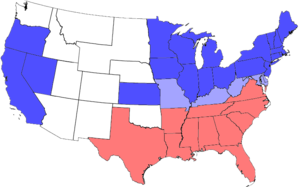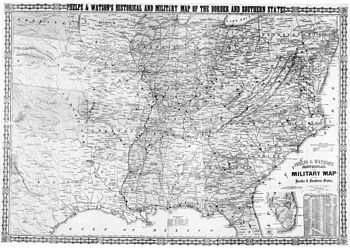

In the American Civil War (1861–65), the border states or the Border South were four, later five, slave states in the Upper South that primarily supported the Union. They were Delaware, Maryland, Kentucky, and Missouri, and after 1863, the new state of West Virginia. To their north they bordered free states of the Union, and all but Delaware bordered slave states of the Confederacy to their south.
Of the 34 U.S. states in 1861, nineteen were free states and fifteen were slave including the four border states; each of the latter held a comparatively low percentage of slaves.[1] Delaware never declared for secession. Maryland was largely prevented from seceding by local unionists and federal troops. Two others, Kentucky and Missouri, saw rival governments, though their territory mostly stayed in Union control after 1862. Four others did not declare for secession until after the Battle of Fort Sumter and were briefly considered border states: Arkansas, North Carolina, Tennessee, and Virginia. They are called the Upper South, in contrast to the Deep South. A new border state was created during the war, West Virginia, which was formed from 50 counties of Virginia and became a new slave state in the Union in 1863 (with, initially, gradual abolition law).[2][3][4]
Lincoln's 1863 Emancipation Proclamation did not apply to the border states, because they were not in rebellion. Of the states that were exempted from the proclamation, Maryland (1864),[5] Missouri[6][7] and Tennessee (January 1865),[7] and West Virginia (February 1865)[8] abolished slavery before the war ended. However, Delaware[9] and Kentucky, while they saw a substantial reduction in slavery, did not see the abolition of slavery until December 1865, when the Thirteenth Amendment was ratified.[10]
With these border southern states of the Upper South having geographic, social, political, and economic connections to both the North and South, the border states were critical to the outcome of the war. They are still considered to delineate the cultural border between the North and South, with the Ohio River being an important boundary between them. President Abraham Lincoln and Confederate President Jefferson Davis were both born in the border southern state of Kentucky, with Lincoln residing in Illinois and Davis residing in Mississippi on the eve of the Civil War.[11]
Reconstruction, as directed by Congress, did not apply to the border states because they never seceded. They did undergo their own process of readjustment and political realignment after passage of amendments abolishing slavery and granting citizenship and the right to vote to freedmen. After 1880 most of these jurisdictions were dominated by white Democrats, who passed laws to impose the Jim Crow system of legal segregation and second-class citizenship for blacks. However, in contrast to the Confederate States, where almost all blacks were disenfranchised during the first half to two-thirds of the twentieth century, for varying reasons blacks remained enfranchised in the border states despite movements for disfranchisement during the 1900s.[12]
- ^ "The Border States (U.S. National Park Service)". National Park Service. Retrieved July 8, 2020.
- ^ Maury Klein, Days of Defiance: Sumter, Secession, and the Coming of the Civil War (Knopf, 1997), p. 22.
- ^ In 1861, "From February into the late spring, North Carolina, Virginia, Tennessee, and Arkansas were considered border states", says David Stephen Heidler et al., eds. Encyclopedia of the American Civil War (2002), p. 252.
- ^ Daniel W. Crofts, Reluctant Confederates: Upper South Unionists in the Secession Crisis, pp. 101–101 ISBN 1469617013.
- ^ "Archives of Maryland Historical List: Constitutional Convention, 1864". November 1, 1864.
- ^ "Missouri abolishes slavery". January 11, 1865.
- ^ a b "TENNESSEE STATE CONVENTION: Slavery Declared Forever Abolished; Emancipation Rejoicings in St. Louis". The New York Times. January 14, 1865.
- ^ "On this day: 1865-FEB-03". Archived from the original on October 8, 2014.
- ^ "Slavery in Delaware".
- ^ Lowell Hayes Harrison & James C. Klotter (1997). A new history of Kentucky. University Press of Kentucky. p. 180. ISBN 0813126215. In 1866, Kentucky refused to ratify the Thirteenth Amendment. It did ratify it in 1976.
- ^ Stephens, Steve (February 15, 2015). "Birthplaces of Lincoln, Davis illustrate divide in 1860s Kentucky". The Columbus Dispatch.
- ^ Ranney, Joseph A. In the Wake of Slavery: Civil War, Civil Rights, and the Reconstruction of Southern Law. p. 141. ISBN 0275989720.